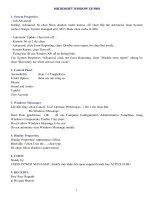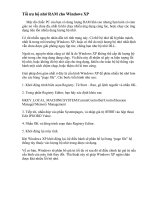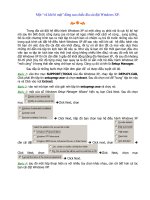- Trang chủ >>
- Sư phạm >>
- Sư phạm toán
Windows XP for power users power pack
Bạn đang xem bản rút gọn của tài liệu. Xem và tải ngay bản đầy đủ của tài liệu tại đây (166.99 KB, 7 trang )
<span class='text_page_counter'>(1)</span><div class='page_container' data-page=1>
<i><b>Int.J.Curr.Microbiol.App.Sci </b></i><b>(2017)</b><i><b> 6</b></i><b>(11): 310-324 </b>
310
<b>Original Research Article </b>
<b>Phosphorus Status in Soils of Eastern Dry Zone, Karnataka, India </b>
<b>M. Chandrakala1*, C.A. Srinivasamurthy2, Sanjeev Kumar3, S. Bhaskar4, </b>
<b>V.R.R. Parama5 and D.V. Naveen6</b>
1
National Bureau of Soil Survey and Land Use Planning, Regional Centre, Hebbal,
Bangalore-560 024, Karnataka, India
2
Director of Research, Central Agricultural University, Imphal, Manipur, India
3
National Dairy Research Institute, Karnal Haryana 132001
4
Department of Agronomy, UAS, Bangalore-560 065, Karnataka, India
5
Department Soil Science and Agricultural Chemistry, UAS, Bangalore, Karnataka, India
6
Deptartment of Soil Science and Agricultural Chemistry, Sericulture College,
Chintamani, Karnataka, India
<i>*Corresponding author </i>
<i> </i>
<i><b> </b></i> <i><b> A B S T R A C T </b></i>
<i><b> </b></i>
<b>Introduction </b>
Phosphorus has been the subject of intensive
research because of its complex nature. The
complexity arises because of three main
factors. First, the total phosphorus level of
soil is low. Second, the native phosphorus
compounds are mostly unavailable for plant
uptake, some being highly insoluble. Third,
when soluble phosphorus sources such as
those in manures and fertilizers are added to
soil, they are readily transformed into
unavailable forms and with time react further
to become highly insoluble forms. Levels of
different pools of soil P have been affected
not only by soil properties and climatic
condition but also by rate and type of P
applied (Myungsu Park <i>et al.,</i> 2006).
The total P content in agricultural crops
generally ranges from 0.2-0.5 per cent.
Analysis of 3.65 million soil samples (1997 -
<i>International Journal of Current Microbiology and Applied Sciences </i>
<i><b>ISSN: 2319-7706</b></i><b> Volume 6 Number 11 (2017) pp. 310-324 </b>
Journal homepage:
Phosphorus (P) deficiency is second to nitrogen (N) and its deficiency is widespread. Soil
based site specific P recommendation for sustainable crop productivity mainly relies on
status, and availability of phosphorus. Representative soil samples (250) from different
agro-ecological regions of Eastern Dry Zone (EDZ) of Karnataka were analysed for P
status and randomly collected samples were analysed for P fractions. Results revealed that,
AvP (Available phosphorus) ranged 12.74 to 94.70; 11.21 to 49.55; 10.70 to 98.32 and
10.22 to 64.05 kg ha-1 in Bangalore Rural, Tumkur, Kolar and Chikkaballapura districts,
respectively. Among P fractions, total-P (range: 1218.90-3383.08 mg kg-1), organic-P
(range: 624.95-3461.85 mg kg-1), reductant soluble-P (range: 132.56-364.55 mg kg-1),
occluded-P (range: 7.38-49.69 mg kg-1) and Ca-P (range: 6.21-38.76 mg kg-1) content
increased as the P fertility of soil increased and decreasing trend was recorded for Saloid-P
(range: 38.31-63.23mg kg-1), Al-P (range: 61.49-164.31mg kg-1) and Fe-P (range:
35.23-109.87 mg kg-1) fractions. Total account of phosphorus is necessary tool for soil based P
recommendation under both irrigated and rainfed agriculture.
<b>K e y w o r d s </b>
Available soil
phosphorus, Eastern
Dry zone Karnataka, P
Fractions.
<i><b>Accepted: </b></i>
04 September 2017
<i><b>Available Online:</b></i>
10 November 2017
</div>
<span class='text_page_counter'>(2)</span><div class='page_container' data-page=2>
<i><b>Int.J.Curr.Microbiol.App.Sci </b></i><b>(2017)</b><i><b> 6</b></i><b>(11): 310-324 </b>
311
1999) indicates that 42 per cent samples are
low, 38 per cent medium and 20 per cent high
in phosphorus (Motsara, 2002). There is an
increasing pressure to reduce the application
of fertilizers in commercial agriculture and
minimize non-point sources of pollution of
both surface and ground waters. There was a
selective crop response to nutrients in
different soils and the responsiveness varied
with soil nutrient status (Mulla <i>et al.,</i> 1992).
Continuous application of phosphorus results
in buildup of this nutrient in the soil. The
buildup of phosphorus depresses the
availability of Zn and S. However, when
nutrient additions are less than the
requirement, the crop draws the soil nutrients.
With such continuous withdrawals, the native
resources diminish with time. Therefore,
application of soil based rather than uniform
rates of fertilizers is must. Further, Import of
DAP increased from 0.6 million tonnes to 2.7
million tonnes during 2007-2008. Thus, to
realize maximum benefits and reduce nutrient
losses from fertilizers, they must be applied in
the right quantity and source based on initial
soil nutrient status.
In the light of the above facts, soils of Easter
Dry Zone of Karnataka were analysed for
available phosphorus and P fractions with an
objective is to assess the status of available
phosphorus and different phosphorus
fractions in soils with different fertility levels.
<b>Materials and Methods </b>
To know the available phosphorus status, 250
soil samples were collected from 4
Agro-Ecological Systems (AES) of Eastern Dry
Zone of Karnataka (Fig. 1) covering parts of
Tumkur, Bangalore (Urban and Rural areas),
Chikkaballapura and Kolar districts.
The details of the sampling areas are
presented in Table 1 along with P status.
Collected soil samples were air dried,
powdered, passed through 2 mm sieve, stored
in polythene bags and were analyzed for
available phosphorus by adopting Jackson,
1973 procedure of Olsen’s extraction method
and Colorimetry for soils pH more than 6.5
and Brays extraction method for soils pH less
than 6.5.
Based on the available phosphorus content,
soils from EDZ of Karnataka were
categorized as Very Low (VL: < 15 kg ha-1),
Low (L: 16-30 kg ha-1), Medium (M: 31-45
kg ha-1), High (H: 46-60 kg ha-1) and Very
high (VH: > 60 kg ha-1) categories. Three
soils from each of these categories were
selected randomly and analyzed for different
P fractions using standard procedure as given
in 2.1.
<b>Forms of phosphorus </b>
<b>Total phosphorus</b>
The total phosphorus was extracted by
digesting the soil with nitric acid and
perchloric acid until a white residue was left.
The residue was filtered and made to a known
volume. Total phosphorus was then estimated
by vanado-molybdo phosphoric yellow colour
method (Hesse, 1971)
<b>Organic phosphorus </b>
Organic phosphorus was determined by
deducting the sum of total inorganic
phosphorus from total phosphorus as
suggested by Mehta <i>et al., </i>(1954).
<b>Available phosphorus </b>
</div>
<span class='text_page_counter'>(3)</span><div class='page_container' data-page=3>
<i><b>Int.J.Curr.Microbiol.App.Sci </b></i><b>(2017)</b><i><b> 6</b></i><b>(11): 310-324 </b>
312
The extracted phosphorus was estimated by
chloro-stannous reduced molybdo-phosphoric
blue colour method (Jackson, 1973).
<b>Forms of inorganic phosphorus </b>
The method outlined by Peterson and Corey
(1966) was followed to fractionate soil
inorganic phosphorus.
<b>Saloid bound phosphorus (Saloid P) </b>
Exactly 0.5 g of soil was taken in to a 50 ml
polyethylene centrifuge tube, 25 ml of 1 M
NH4Cl solution was added and shaken for 30
minutes. Saloid-P was estimated by
molybdo-sulphuric acid reagent, using stannous
chloride as reductant after taking the extract
from supernatant solution after centrifugation
in to an aliquot of 10 ml isobutyl alcohol.
Blue colour intensity was measured at 660 nm
using spectrophotometer.
<b>Aluminium phosphorus (Al-P) </b>
The soil residue left after saloid-P estimation
was shaken for one hour with 25 ml of 0.5 M
NH4F (pH 8.2). The Al-P in the supernatant
centrifuged suspension was determined by
chloro-molybdic-boric acid reagent and
chloro-stannous reductant. The intensity of
blue colour developed was read in
spectrophotometer at 660 nm.
<b>Iron phosphorus (Fe-P) </b>
The soil sediment from Al-P estimation was
washed twice with 25 ml portion of saturated
NaCl solution by shaking and centrifuging.
The soil was then treated with 0.1 M NaOH
and shaken for 17 hours and centrifuged. The
supernatant solution was then treated with
five drops of concentrated sulphuric acid.
Phosphorus free activated carbon was used to
remove suspended organic matter. The Fe-P
content in the filtrate was determined by
chloro-molybdic-boric acid reagent and
chloro-stannous reductant. The intensity of
blue colour developed was measured using
spectrophotometer at 660 nm.
<b>Reductant soluble phosphorus (R-P) </b>
The soil residue from Fe-P estimation was
washed twice with 25 ml of saturated NaCl
solution by shaking and centrifuging. Soil was
then suspended in 15 ml of 0.3 M sodium
citrate solution and shaken for 15 minutes
with 0.5 g sodium dithionate. The suspension
was heated on a water bath at 80 ºC for a few
minutes. Clear supernatant solution was
decanted into a 50 ml volumetric flask after
centrifugation. Soil was then washed twice
with saturated NaCl and the washings
returned to sodium citrate-dithionate extract
which was taken for R-P estimation. Excess
of citrate and dithionate were oxidised by 1.5
ml of 0.25 M KMnO4 solution. The R-P was
estimated by molybdate-sulphuric acid
reagent with stannous chloride as reductant
after taking the extract into an aliquot of 10
ml isobutyl alcohol. The blue colour intensity
developed was diluted with equal quantity of
absolute ethyl alcohol and read at 660 nm in
spectrophotometer.
<b>Occluded phosphorus (Occl-P) </b>
The soil residue left out in the estimation of
R-P was added with 25 ml of 0.1 M NaOH
and shaken for one hour. Supernatant solution
after centrifugation was taken for estimation
of Occl-P by chloro-molybdic-boric acid
reagent with chloro-stannous reductant.
<b>Calcium phosphorus (Ca-P) </b>
</div>
<span class='text_page_counter'>(4)</span><div class='page_container' data-page=4>
<i><b>Int.J.Curr.Microbiol.App.Sci </b></i><b>(2017)</b><i><b> 6</b></i><b>(11): 310-324 </b>
313
chloro-molybdic-boric acid reagent with
chloro-stannous reductant.
<b>Results and Discussion </b>
<b>P status</b>
The nature and distribution of different forms
of P provides useful information for assessing
the available P status of soil. Estimation of
available P indicates only the amount of P
present in soil solution and soil surface which
is available to plants but it does not indicate
about the relative contribution of different
fractions of P towards available P
(Lungmuana <i>et al.,</i> 2012).
In Bangalore rural district, available
phosphorus content ranged from 12.74 to
94.70 kg ha-1 whereas in Tumkur district, it
ranged from 11.21 to 49.55 kg ha-1. Similarly
in Kolar distict, the available phosphorus
content of soil ranged from 10.70 to 98.32 kg
ha-1 and it ranged from 10.22 to 64.05 kg ha-1
in Chikkaballapura district (Table 1). The
higher available P in soil may be due to
buildup of P due to continuous addition of P
fertilizer for the crops. Low in available P
content of soil recorded may be due to regular
cultivation with inadequate supply of
phosphorus to crops. Higher levels of
fertilizer P are needed in soils testing very
low and low. Fertilizer P to be applied can be
reduced when soils test very high in available
P. Sharma <i>et al.,</i> (2012) reported the available
P in Trans-Gangetic Plains, Upper Gangetic
Plains, Middle Gangetic Plains and Lower
Gangetic Plains was in the range of 6.7–85.1,
4.5–155.0 and 4.7–183.7, 2.2–112.0 kg ha-1,
respectively. Gurinderbir Singh and Sharma
(2007) reported that the soils of Punjab
showed low to high in available P.
Laxminarayana (2007) noticed Brays’1
available P status ranged from 6.56 to 10.93
kg P ha-1 in rice growing soils of Mizoram.
Hasan (1996) reported that the available
phosphorus status in Karnataka was ranged
from low (16 %) to medium (3 %). Myungsu
Park <i>et al.,</i> (2006) reported that the higher
level of P remaining in the soil is accumulated
by long-term annual application of compost
and chemical fertilizers than by that of
chemical fertilizer, and P accumulation might
be a gradual saturation of the P-sorption
capacity.
<b>Categorization of soil available phosphorus </b>
<b>(P2O5) </b>
Categorization of soil available phosphorus
(Table 2) found that 43.20 per cent of soil
samples comes under low (<22.90 kg ha-1)
and 43.20 per cent of soil samples comes
under medium (22.9-56.33 kg ha-1) category,
which represents 108 samples each, in the
total 250 samples. High (> 56.33 kg ha-1)
category showed 13.60 per cent (34 soil
samples). Percentage of soil samples under
different category are arranged in the
ascending order as follows:
Low = Medium > High
<b>Phosphorus fractions </b>
</div>
<span class='text_page_counter'>(5)</span><div class='page_container' data-page=5>
<i><b>Int.J.Curr.Microbiol.App.Sci </b></i><b>(2017)</b><i><b> 6</b></i><b>(11): 310-324 </b>
314
medium, high and very high P fertility soils,
respectively.
The mean organic-P values was lower (709.33
mg kg-1) in very low P fertility soil and was
higher (2819.10 mg kg-1) in very high fertility
soil. The values ranged 624.95 – 833.75,
1204.06 – 1500.75, 1664.60 – 1679.93,
1970.06 – 2210.73 and 2231.52 – 3461.85 mg
kg-1 in very low, low, medium, high and very
high P fertility soils, respectively.
<b>Table.1 </b>Soil available phosphorus status in EDZ of Karnataka
<b>Sl. </b>
<b>No. </b>
<b>Agro-Ecological Situations (Name of the </b>
<b>taluk and village) </b>
<b>Available P2O5 </b>
<b>(kg ha-1) </b>
<b>Previous crop </b>
<b>grown </b>
<b>Bengaluru Rural District: Doddaballapurataluk </b>
1 Saslu 65.59 Maize
2 Saslu 24.50 Ragi
3 Thadalabandde 70.97 Ragi
4 Kankenahalli 61.63 Maize
5 Adakavala 26.37 Maize
6 Kadathippuru 84.81 Maize
7 Akkatammanahalli 16.37 Ragi
8 kattivasanahalli 32.74 Ragi
9 Doddabelavangala 31.20 Ragi
10 Sonnenahalli 69.10 Ragi
11 Turuvanahally,Tubgere 36.58 Ragi
12 Lakkasandra, Tubgere(H) 29.88 Maize
13 Tubgere(H) 67.45 Maize
14 Tubgere(H) 79.98 Maize
15 Hadonahally 58.12 Maize
16 Kansavadi 30.32 Ragi
17 Honnavara 18.90 Ragi
18 Purushanahally 13.73 Ragi
19 Hambalgere 18.13 Ragi
<b>Bengaluru Rural District: Nelamangala taluk </b>
20 Hegunda 72.51 Ragi
21 Narasipura 39.66 Ragi
22 Bugudihally 29.77 Ragi
23 Makenahally 51.19 Ragi
24 Enchenahally 27.47 Ragi
25 Kundanahally 39.88 Ragi
26 Adivasahalli, Thyamagondadlu 16.15 Ragi
27 Thyamagondadlu 29.55 Ragi
28 Thyamagondadlu 13.29 Ragi
29 Thyamagondadlu 23.29 Ragi
30 Kalghatta 19.34 Red gram
31 Mallumghatteri 49.99 Ragi
32 Thippaganahalli 19.01 Ragi
33 Mallarabanavadi 26.59 Ragi
34 Basavanahalli 28.12 Ragi
35 Mylayahalli 27.90 Ragi
36 Rampura 69.32 Potato
</div>
<span class='text_page_counter'>(6)</span><div class='page_container' data-page=6>
<i><b>Int.J.Curr.Microbiol.App.Sci </b></i><b>(2017)</b><i><b> 6</b></i><b>(11): 310-324 </b>
315
37 Tindlu, 51.85 Red gram
38 Neraganahally 83.38 Ragi
39 Open filed Jail, Koramanagla 35.70 Ragi
40 Open filed Jail, Koramanagla 41.97 Vegetables
41 Open filed Jail,Koramanagla 54.05 Ragi
42 Open filed Jail,Koramanagla 17.91 Maize
43 Ahuti 35.92 Ragi
44 Vijayapura 48.56 Ragi
45 Vijayapura 12.74 Ragi
46 Patna 15.93 Ragi
47 Patna 26.92 Ragi
48 Patna (H) 29.77 Ragi
49 Sulibele 23.62 Ragi
50 Sulibele 34.83 Ragi
51 Teneuoor, Sulibele 30.87 Ragi
<b>Bengaluru Rural District: Hoskotetaluk</b>
52 Chikkaallalagere 38.34 Ragi
53 Tharibehalli 16.48 Ragi
54 Kariberanahosahalli 94.70 Ragi
55 Kariberanahosahalli 31.75 Ragi
56 Kariberanahosahalli 13.62 Ragi
57 Hraluru, Haralemakanahalli 31.31 Ragi
58 Chimundanahalli 62.73 Ragi
59 Chimundanahalli 87.78 Ragi
60 Kannuralli 38.89 Ragi
61 Halapanahalli 62.95 Ragi
62 Lakondahalli 49.44 Ragi
63 Nandugudi 40.87 Ragi
64 Banahalli 25.71 Ragi
65 Indiganala 20.65 Ragi
66 VaddarahalliTq 22.85 Ragi
67 Araluru Tq 49.11 Ragi
<b>Tumkur district : Gubbitaluk</b>
68 M.H. Patna, 51.85 Paddy
69 Ammanaghatta 32.30 Ragi
70 Channashettyhalli 13.95 Paddy
71 Gubbi 12.53 Paddy
72 Mattighata 13.51 Ragi
73 Nittur 11.21 Ragi
74 Kundernally 19.45 Ragi
75 Kundernally 14.39 Ragi
76 Doddaguni 17.58 Red gram
77 Doddaguni 15.60 Red gram
78 Godekeregate 14.39 Red gram
<b>Tumkur district : Chikkanayakanahallitaluk</b>
79 Godekere Gate 11.54 Ragi
80 Chikkanayakanahalli 19.56 Ragi
81 Chikkanayakanahalli 19.34 Ragi
82 Maligehalli 17.36 Ragi
</div>
<span class='text_page_counter'>(7)</span><div class='page_container' data-page=7>
<i><b>Int.J.Curr.Microbiol.App.Sci </b></i><b>(2017)</b><i><b> 6</b></i><b>(11): 310-324 </b>
316
84 Sulakatte 17.69 Ragi
85 Sulakatte 21.09 Red gram
<b>Tumkur district : Tiptur</b>
86 Mallenahally 18.68 Ragi
87 Tiptur 17.91 Ragi
88 Mattihally 18.68 Ragi
89 Shankrikoppalu 13.40 Red gram
90 Linganahally 15.38 Ragi
91 B.G Palya 18.79 Ragi
92 Sorekunte 13.73 Red gram
93 Sorekunte 49.55 Ragi
94 Dodderi 16.04 Ragi
95 Ballapura 20.43 Ragi
<b>Kolar district</b>
96 Jodikrishnapura 28.89 Ragi
97 Achatnalli 65.48 Ragi
98 Kurkinarasapura 29.55 Ragi
99 Chowdenahalli 30.21 Ragi
100 Karinakanahalli, Malur 20.98 Ragi
101 Malur 98.32 Ragi
102 Malur 59.76 Ragi
103 Malur 82.72 Ragi
104 Malleshwarnagar 33.40 Ragi
105 Vakkaleri 89.54 Cauliflower
106 Chinnapura 57.57 Ragi
107 Dandiganahalli 101.40 Ragi
108 Beglihosahalli 24.72 Ragi
109 Ammerehally 30.76 Ragi
110 Beglibenjanahalli 33.40 Ragi
111 Chatrakodihally 61.52 Ragi
112 Mudiyalla 38.78 Ragi
113 Chatrakodihally 61.52 Ragi
114 Mudiyalla 38.78 Ragi
115 Vemgal 28.45 Ragi
116 Kurngal 68.33 Ragi
117 Harjenahally 64.82 Ragi
118 Nagunalu 57.13 Ragi
119 Nagunalu 44.16 Ragi
120 Busunahalli 53.39 Ragi
121 Busunahalli 97.01 Maize
122 Hurugali 58.99 Ragi
123 Oluru 6.59 Ragi
124 Marenahalli 35.92 Ragi
<b>Kolardistrict:Mulabaglu</b>
125 Mudiyannur 48.01 Ragi
126 Kurudumalai 48.67 Ragi
127 Kadaripura 49.33 Ragi
128 Mulabaglu 69.76 Ragi
129 Kuruibarahally 60.20 Ragi
</div>
<!--links-->
Hướng dẫn Repair Windows XP
- 2
- 871
- 2








